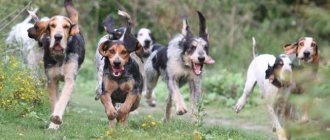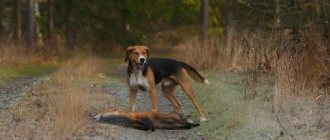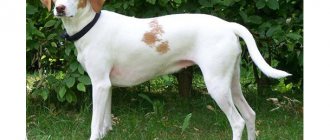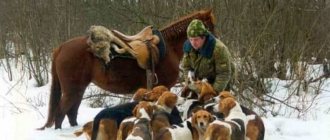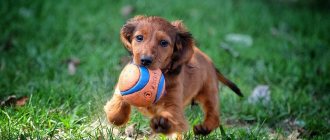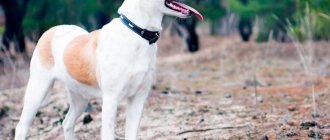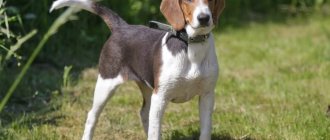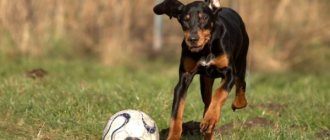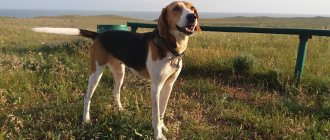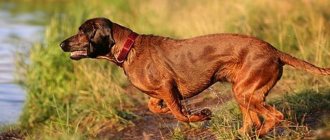Breed characteristics
| Short description | |
| Origin: | Belgium |
| Conditions of detention: | In a spacious apartment, in a large country house |
| Purpose: | Companion dog, herding dog, rescue dog, caregiver dog |
| Color: | Red, reddish-brown, fawn, black and tan, black |
| Wool length: | Short, smooth |
| Adult dog size: | The height of females is 58-64 cm, the height of males is 62-69 cm, the weight of males is approximately 40-52 kg, and that of females is 35-45 kg |
| Average life expectancy: | 10-12 years |
| Walk: | Mandatory (2 walks per day, 45 minutes each) |
| Physical activity needs: | High physical demands |
| Fédération Cynologique Internationale (FIC) classification: | Group 6: hounds and related breeds; Section 1: hounds, subsection: large hounds |
| Puppy price: | An ordinary puppy – from 60,000 rubles, from champion parents – 80,000 rubles |
History of the origin of the species
Dogs of the Bloodhound breed have a very rich and interesting history, and this breed began to be bred in the Belgian open spaces by monks. At the beginning of the 10th century, dogs were transported to England. This was facilitated by the actions of William the Conqueror.
The dogs' ability to hunt was immediately received very cordially, and their amazing sense of smell was useful for performing all kinds of search operations . This ability was first tried in America. Bloodhounds could track a person with incredible ease even in the most seemingly advanced cases, and their incredible endurance helped them make their way through dense forests.
Also, dogs of this breed were used in catching criminals, as they were very good at finding the real criminal by smell from the crime scene.
While working with this breed, it was noticed that the dogs did not show aggression at all and all sorts of attempts in the future to somehow develop it in animals were not successful.
Dogs were brought to Russia only in the 16th century. However, after the death of Peter the Great, interest in the breed became less and less, and later the dogs completely disappeared from our country.
Interest in the breed was revived again closer to the middle of the 20th century. We can say that today these animals are not particularly popular, but there are still a small handful of hobbyists who breed these animals.
History of the breed
Dogs with an unusually keen sense of smell existed in the Mediterranean countries, long before the advent of our era. Bloodhounds are representatives of the oldest type of hounds, although the appearance of the dogs has seriously changed thanks to the efforts of people.
Bloodhounds were bred in Ancient Greece. Over time, these dogs appeared in Ancient Rome. From there, hunting dogs spread throughout Europe.
The author of the book “History of Animals,” Claudius Aelian, spoke with delight about bloodhounds in the 3rd century: in his opinion, these hounds have no rivals in flair and determination. If a dog is on the trail, it will not stop until it finds the animal.
In the 8th century, black and white bloodhounds came under the patronage of the brethren of the monastery of St. Hubert. The monks preserved and improved the breed - for several centuries they bred and crossed Bloodhounds with other dogs, obtaining several new breeds of hounds: English, French, Swiss. All new breeds showed the characteristic features of Bloodhounds: folds on the skin and long, drooping ears.
Representatives of the highest clergy of the 12th century did not consider it shameful to participate in hound hunting; kennels had a place in any monastery, and in huge packs of hounds, bloodhounds were always given special attention. No other dog could successfully find the animal using the old trail. The breed was valued and carefully preserved.
Hounds were also actively used as bloodhounds. In Britain in the 17th century, there were laws requiring bloodhounds to be called upon for guard duty and prohibiting residents from obstructing the dog's entry into the house. Moreover, if a dog in service showed a desire to enter, the owners were obliged to open the door for him. There was one penalty for refusing to cooperate with a dog: death.
The name of the breed was given by the desire to preserve the best qualities of dogs: bloodhound is translated from English as “purebred hound”.
The English doctor Johann Caius, a famous dog lover, explained this name differently: dogs follow the bloody trail of the victim. A wounded animal, which has enough strength left to escape from the hunter, still leaves blood, and these hounds begin to pursue the scent of blood. Therefore, they are rightfully called “blooded”.
It was Caius who mentioned the alternative use of the breed: if the thieves did not leave traces of blood, the dog will still follow the trail for long distances, find the thief in the crowd, make his way through impassable thickets, even swim across the river and pick up the trail on the other side, circling a little to find him.
At the beginning of the 17th century, black bloodhounds became constant companions of English hunters, helping in the hunt for deer, wolves, and lynxes. By this time, the appearance of the dogs was as close as possible to the modern one. They are not known for their speed, but their amazing instincts and determination in pursuing animals on the trail are unparalleled. The rest of the hounds were already following the bloodhound who had taken the trail.
Bloodhounds arrived in the New World at the same time as Europeans. There, dogs found a new use and hatred among blacks: slave hunters. Bloodhounds were used to track slaves who had escaped from plantations. Persistent hunters could pursue prey over 100 kilometers. It was in the USA that bloodhounds finally acquired their modern appearance. But during the Civil War, purebred dogs were almost completely exterminated by former slaves.
We advise you to read: Dog breed Hortaya Greyhound
Artists who belonged to the movement of fighters for the abolition of slavery in the United States in the 18th and 19th centuries often chose the pursuit of fugitive slaves by bloodhounds as a subject for their paintings.
The breed is registered in the International Canine Association as Belgian, although it acquired its qualities thanks to English monks, and was finally formed with the active participation of American slave owners.
In Russia, bloodhounds appeared under Peter the Great - the dogs were bought for the Izmailovo menagerie for a lot of money. But after the death of the emperor, no one was interested in the hounds. Professional breeders of this breed appeared only in the USSR in the late 1980s.
Now the main purpose of the breed is as companion dogs or show dogs. Although hunting dogs have also survived - they are equally successful in tracking down large and small game - from elk to badgers. It is believed that females are more suitable for hunting. Bloodhounds work most effectively by following a blood trail - tracking down wounded animals.
Distinctive features
The main traits of Bloodhounds are:
- head is a massive skull with a square shape. In the frontal region and near the cheeks there are certain folds on the skin that sag when the head is tilted. This is especially noticeable in males.
- The nose is massive black or brown with rather wide nostrils. The lips are large and soft, the upper lip covering the lower lip.
- The bite is usually scissor-shaped, but according to the standard it can also be straight. The jaw is large with white teeth.
- Eyes , as a rule, have a brown or hazel color, less often amber, and are of medium shape. Due to a sagging lower eyelid, redness in the corners of the eyes is allowed.
- The ears of animals are quite soft and pleasant to the touch, thin, and set low.
- neck is long and with pronounced muscles. This allows dogs to sniff the ground and identify all kinds of tracks.
- back , with a strong loin and a broad chest. The tail is soft, saber-shaped.
- The legs are strong and muscular.
- The skin is soft and elastic.
Description of the Bloodhound breed
St. Hubert's hounds are multidisciplinary and multifunctional dogs. Their main purpose is to hunt large game (wounded) using a blood trail. Due to their super-fine, phenomenally keen sense of smell and ability to follow a significant trail in any terrain, Bloodhounds are used in various police and search and rescue operations. The breed is not known for its agility; the dogs do everything slowly, but very persistently and purposefully.
Bloodhounds are unsurpassed bloodhounds
Bloodhounds are recorded in the Guinness Book of Records; several dogs found missing people after 322 hours using the tracks they left. Cases when a dog followed a trail for a hundred or more kilometers (maximum 220 km) are far from isolated.
Recently, royal hounds are increasingly kept as exotic show pets, as well as domestic and family dogs.
Appearance
The appearance of the Bloodhound is charismatic, bright and memorable. Of the entire vast family of hounds, these dogs are the most raw and powerful. The dogs are large, strong, majestic and noble, harmoniously built with a heavy, massive bone structure and a well-developed voluminous muscle corset. However, the animal does not look clumsy, awkward or overweight, despite its decent dimensions. The general format of the body is rectangular, the elongation index (height at withers to body length) is 9:10. Muscular body with a strong, elongated, straight and wide back, barely defined withers, oval, widened and well dropped (a clear keel is formed between the forelimbs) long sternum, slightly convex, strong loin and slightly tucked (not saggy) belly. The lines of the bottom and top are almost horizontal and parallel.
Hubert's hounds are large and powerful dogs
Breed standard:
- Body weight: females - 40–48 kg;
- males - 46–54 kg.
- females - 62 cm;
The Bloodhound moves gracefully and rhythmically, more sweepingly than other hounds, pushing strongly with its hind limbs and swinging its forelimbs widely. At the same time, the amplitude of the legs is the same, they move in parallel, and the top line always remains horizontal. The movements are elastic, free and springy, smooth and swaying (which is typical for this breed), but not crab-like (moving sideways).
Bloodhound moves powerfully and sweepingly
The coat is short, rough, dense and dense, fitting well to the body and protecting from bad weather. More delicate and soft to the touch, very short hair on the head and ears.
The standard allows only three types of color:
- solid monochromatic red (red);
- brown-red;
- black and red.
Two-colored individuals have a large dark area on the back; there are darkening areas on the face, limbs, around the eyes, on the cheekbones and under the tail. Dark areas may have small light inclusions; colors are not clearly limited. Small white markings on the tip of the tail, paws and chest are acceptable.
Disadvantages and disqualifying vices
The disadvantages are:
- not a characteristic thoroughbred appearance (square format, lack of noble expression on the face, excessive looseness, long legs or stockiness, etc.);
- not a thoroughbred head (sloping forehead, excessively falling forward folds, a very narrowed or massive and wide skull, the occipital protuberance is not sufficiently pronounced, a sharp stop, a concave line of the nose, etc.);
- poor pigmentation of lips and nose;
- lack of teeth;
- ears set high, short, thick, or very close to the cheekbones;
- deep-set, small eyes, excessively drooping, loose lower eyelid;
- small dewlap, weak, thin or short neck;
- low-set, curled, curled or broken tail;
- blurred or light coloring;
- timidity and uncertainty.
The reasons for disqualification will be:
- deviations in height and weight from acceptable limits;
- any color that does not correspond to the standard;
- light yellow iris;
- problems with the jaws (overshot, undershot, misaligned);
- abnormal pigmentation of the lips and nose (depigmentation);
- inconsistency with the general breed type of appearance;
- cowardice or aggressiveness;
- obvious physical abnormalities.
Character and psyche of the breed
An aristocratic and intelligent Bloodhound has a calm, balanced, gentle and friendly character. The dogs are very sociable and sociable, completely devoid of any aggression . Strangers are always welcome and greeted sincerely, without expecting any catch. It is for this reason that bloods make useless guards and watchmen. However, despite some phlegmatism, these calm pets cannot be called weak-willed. They, like all hounds, can be stubborn and are also capable of making independent decisions, sometimes going against the owner’s opinion. For novice dog breeders, this breed is not the most suitable option.
Bloodhounds get along well with children of all ages.
St. Hubert's dogs are devoted to the family in which they live, but they do not allow anyone to twist themselves into ropes. An exception is made only for children; the dog can fiddle with them for hours, taking part in all the games and pranks. He behaves extremely carefully and will not intentionally harm the child. In most cases, it is not the human cub that has to be protected, but, on the contrary, the big dog that allows too much and tolerates everything. Considering the size of the animal, it is still not worth leaving it alone with babies, since a large bloodhound can drop a toddler with an awkward movement of the pelvis or one swing of its thick tail.
The dog is tolerant of all other pets; aggression is possible only in the case of same-sex individuals. She can even make friends with a cat, subject to correct and early socialization. Hardworking and patient dogs are able to sniff the territory for many hours; hunting and constant searching are natural and normal for them. Bloods have a powerful, trumpet and low voice, but they rarely use it.
While working, the hound's other senses are switched off, it stops responding to commands and may get lost.
Photo of an adult dog
Photos of puppies
Features of character and behavior
These dogs are very aristocratic and can have great love for their household, especially children. Dogs allow them to do whatever they want with them. Parents even sometimes have to protect their pet from restlessness. Here you should explain to your children that there is no need to cause pain and suffering to an animal, and especially not to take away its personal belongings and toys.
Among the variety of pets, shy and timid specimens are often found, but they are by no means devoid of stubbornness. Thanks to this trait, parenting should be special, combining care and confidence at the same time.
Advantages
- Bloodhounds get along very well with other pets and rarely conflict . They are usually always friendly and hospitable.
- The pets' unique sense of smell helps them follow a scent that was left more than 4 days ago and search for a target, avoiding any obstacles in their path.
- This is a unique breed of dog whose skills are used in searching for missing children lost in the forest, as well as in finding people from under the rubble of a collapsed building.
- The dog also amazes with its exceptional cleanliness and kindness, especially in relationships with children . He is a little distrustful of unknown people, but does not show aggressiveness. It takes a certain amount of time to completely trust a stranger.
Flaws
- When walking, it is best to keep animals on a leash, as the restless scent of pets can make them run far from their owners and get lost.
- Dogs are famous for their special smell, which not all people like , and they also often howl and bark, which is also not to everyone’s liking. Please note that these pets often drool.
- Bloodhounds love food very much, and if the circumstances are favorable, they can eat too much to their detriment . You should always monitor your pet's diet very carefully.
Character
In appearance, the Bloodhound seems to be a formidable and unapproachable dog. Indeed, he is calm and balanced, but aggression is not inherent in him at all. These are courageous, hardworking dogs, but they often show stubbornness, which only a strong-willed owner can overcome.
The Bloodhound combines completely different character traits: stubbornness, timidity, mischief, courage, shyness, fearlessness, tenderness, friendliness, stiffness, hard work.
The most important thing in the life of a bloodhound is the hunting instinct, the excitement of pursuit, and the study of foreign odors. Such manifestations need to be monitored, especially when being with the dog in public places.
He is friendly and affectionate towards children. This dog patiently endures the pranks of children. So adults need to supervise children’s interactions with Bloodhounds. Only in this case we are protecting not the kids from the dog, but the dog from children’s antics.
You can't make a guard out of a Saint-Hubert dog. She has such a low level of aggressiveness that there is a possibility of a friendly attitude towards strangers who have unauthorizedly entered the owner’s territory. These dogs seem to love everyone around them. Although each dog is individual in its own way. Character largely depends on upbringing, socialization and conditions of detention.
The Bloodhound gets along well with pets. However, conflicts often occur between animals of the same sex, especially between male dogs.
Care and maintenance
Dogs are not particularly picky eaters. They have thick, short hair that can be easily brushed with a special brush several times a week.
- It is also not recommended to wash your pet very often unless it is very dirty. After you have washed your dog, dry it with a towel, but do not blow dry it. This will be enough for the dog’s coat to acquire a healthy shine and look flawless.
- ears need to be cleaned a couple of times a month using wet wipes or swabs.
- Due to sagging eyelids, eyes are a rather vulnerable place for various types of infections. They need to be periodically checked and processed, washing the clogged areas. This can be done with regular tea leaves.
- If the dog lives in a city apartment, then the owner needs to purchase a nail clipper for systematic trimming of the nails.
- Physical activity should be present daily in the life of a pet . The main thing is to play with the dog on a regular basis and not let him go into his favorite pastime - sniffing the smells on the ground and looking for tracks. It is best to walk the animal for 1-1.5 hours.
- The dog's skin also needs to be constantly monitored because it tends to fold and smudge . Moreover, Bloodhounds' eyelids can turn out, so they need to be examined quite often. If a disease is detected, it is recommended to immediately visit a veterinary clinic, because this disease does not go away on its own.
Often, Bloodhound problems also lie in the skeleton and muscles. This is mainly due to unbalanced nutrition during the pet’s formation.
Nutrition
The main thing in the nutrition of these animals is to prevent changes to the usual menu, because this is fraught with problems with the gastrointestinal tract. And that is why future owners need to ask previous owners about the puppy’s diet.
- The amount of food per day is usually one fifth of the dog's weight. A prerequisite is the presence of a sufficient amount of minerals and vitamins. All this is done under the strict guidance of a veterinarian.
- The dog's diet must include dairy products, cereals, and a variety of vegetables (except potatoes).
- It is very important to feed your pet meat. It should be present in 2/3 of the animal’s diet. Fish dishes are also welcome. The fish must be boiled. Turkey and chicken meat must also be boiled before serving, after removing the bones.
- It is not recommended to feed your animal exclusively dry food. It is better to use them as an additional source of nutrients.
- Not far from the food, the dog must have a bowl of clean water. If we are talking about a country house, then water can be kept at the exit from the house.
And the main thing is to prevent the animal from overeating. If he has eaten a lot, he must burn the calories he receives.
As your pet gets older, the number of feeding times decreases.
If the puppy is 1 month old , then feeding is done up to 6 times every 3 hours . Upon reaching the age of 4 months , the puppy begins to be fed 4 times a day every 3 hours . If the puppy is already 6 months old , then feed him 3-4 times every 4 hours . Ultimately, they switch to standard two meals a day.
Health
This dog breed is quite strong in structure . The main disease that accompanies the animal is bloating, which can be avoided by placing the pet's bowl at an angle.
Vaccinations
- The very first vaccination is given to puppies at 9 weeks of age and, as a rule, it is done by breeders. The procedure is repeated only after 3-4 weeks .
- An adult dog is vaccinated every year and before the operation itself, the animal is first dewormed.
- After the procedure, the dog is not taken outside and is not washed . Adaptation to the vaccine will occur over the course of 12 days Owners should monitor the puppy very closely during this period, as this is the most vulnerable time for him. Often, after 1 vaccination, puppies may have a fever, apathy and drowsiness.
- After 3 weeks, the second vaccine is given. During this period, the dog also does not need to be taken for walks and protected from other animals.
- At the age of six months, puppies are vaccinated against rabies. However, if during this period the dog’s teeth are developing, it is worth waiting.
- At one year old, the puppy already receives a comprehensive vaccination, which is done every subsequent year.
Diseases
Among the main diseases in Bloodhounds are::
- bloating or volvulus;
- epilepsy;
- skin problems (dermatitis);
- entropy;
- cherry eye;
- hip dysplasia.
Walk
It is best for pets to be kept in a large country house. The Bloodhound has extraordinary endurance, so if the dog often runs outdoors, then for this you need to purchase a special collar against fleas and ticks.
It is very important to help dogs get out their energy, but not to overwhelm the puppies with a lot of physical activity.
The best thing is to walk your pet 2 times a day for 50 minutes. And it’s best to combine walks with games.
Grooming
- Bloodhounds have a short coat, but due to their activity they often get dirty. This applies to the ears in particular, because when eating food they often end up in the bowl.
- It is necessary to wash your pet with special shampoos with PH balance . The shampoo is made like this: dilute the concentrated mixture in water in a ratio of 1 to 3. Be sure to rinse it well from the animal’s fur. Human shampoos are not suitable for Bloodhound coats.
- The animal should dry out in a warm room without drafts . And only after the animal is completely dry can it be walked. The wool is combed using special rubber brushes. When shedding occurs, dogs need to be brushed daily. It is best to carry out the procedure outdoors to avoid getting hair on the carpet and furniture.
Bloodhound Health and Diseases
In general, this dog is quite strong and rarely gets sick. But sometimes she may experience health problems such as:
- cherry eye;
- bloating;
- volvulus;
- dysplasia of the elbow and hip joint (typical of many large dogs).
Improper feeding may well lead to diseases affecting the musculoskeletal system.
In addition, eye problems occur quite often. Drooping skin pulls down the eyelids, which can allow dust to get into the eyes, causing conjunctivitis. To prevent this from happening, your eyes need to be examined regularly and, if necessary, consult a specialist.
Cherry eye
Vaccinations required for a bloodhound
Everything is standard with vaccinations - the types are exactly the same as for other dogs, namely: against distemper, rabies and infections. The first vaccination is given at the age of two months, and the second – three weeks later.
Mating
- The animal begins to mature much earlier than the ability to bear fruit appears.
- It is very important to wait until the pet has matured emotionally and only then start breeding. It is then that the female will be able to bear healthy offspring.
- The very first estrus begins in the female at 12 months, but mating does not take place at such an early age.
- Mating takes place no earlier than the pet’s 2nd year of development. Pets usually go into heat in spring and autumn.
During mating, the bitch is brought to the male's territory. It is imperative that the environment is calm and good. The best time is considered to be the morning after a walk.
Key points in training
- In order for the animal to follow all commands and obey, it is important to put in a lot of effort. He has natural stubbornness and willfulness and therefore cannot be treated cruelly with pets.
- When training, it is important to be kind, patient and moderately strict . Males have a more stubborn disposition. It is necessary to work with them gradually so that the character becomes calmer.
- Read about how to properly train a dog in the article: “Training a puppy: effective methods from dog handlers, learning commands at home.”
Bloodhound: a brief historical background about the dog
A real beauty.
In general, the birthplace of the breed is Belgium. The exact time of its appearance is unknown, but experts settled on the thirteenth century.
The main purpose of bloodhounds was to protect high-ranking officials, including the English king Henry the Eighth. In addition, the Bloodhound is a hound that did an excellent job of finding fugitive criminals.
Curious! The name bloodhound comes from two English words - blood (blood) and hound (hound), that is, it can be translated as “hound walking through the blood.”
However, they found application in other areas. For example, the famous conquistador Gonzago Pizarro, going to South America in the mid-sixteenth century to explore the Peruvian jungle, took with him about a thousand dogs of this breed, which established themselves as reliable companions.
How to choose a puppy
If future owners have a desire to purchase dogs with such a stubborn character, then they need to contact the breeders and carefully choose a puppy. Only after communicating with the breeders will it be possible to fully understand whether the future owner will be able to cope with such a stubborn dog.
The specialist will explain all the nuances of the breed, its character and behavioral characteristics. When choosing a nursery, be guided by real reviews from people and be careful .
- You can pick up your baby from the nursery at the age of 8 weeks.
- A puppy's appearance can say a lot about its health. Ideally , this is a well-fed, cheerful animal with great activity and a thirst for adventure .
- The coat should be shiny and the nose should be wet. During walks, your pet should expend as much energy as possible. But the owner must understand that it is impossible to overexert the puppies, because in the future this can negatively affect their joints.
- A mark is usually placed inside the ear or groin , which must be the same as the number in the pet’s passport, where all vaccinations must also be recorded.
It is worth remembering that such animals are only suitable for people who lead an active lifestyle and also have good experience in keeping dogs. This breed makes you fall in love once and for all.
Bloodhound Care
Of course, in order for the Bloodhound Bloodhound to feel comfortable, not get sick, and live a long, happy life, she needs to be provided with appropriate care. And there can be no trifles here.
Features of feeding and diet
Breeders who are accustomed to feeding their dogs dry food should choose only elite food based on natural meat, not soy. They are not cheap, so it is easier to prepare food for your pet yourself.
Optimal ratio:
- Beef by-products and meat – 30%.
- Porridge (millet, buckwheat, rice) – 40%.
- Boiled vegetables – 40%.
Sometimes you can enrich the diet with hard-boiled eggs, fish and dairy products: they are rich in calcium, which is very important for large dogs.
Remember! Like many dogs, Bloodhounds have no sense of proportion when it comes to food. Therefore, the diet must be strictly limited, especially if the pet spends most of its time in the apartment.
A good treat would be pieces of not too sweet fruit, white bread croutons and dried offal.
Grooming
Their coat is short, stiff, and lies tightly to the body. Thanks to this, you don’t need to spend a lot of time caring for it—it’s enough to comb the dog once a week with a special mitten to collect the hair, and at the same time give your pet pleasure.

